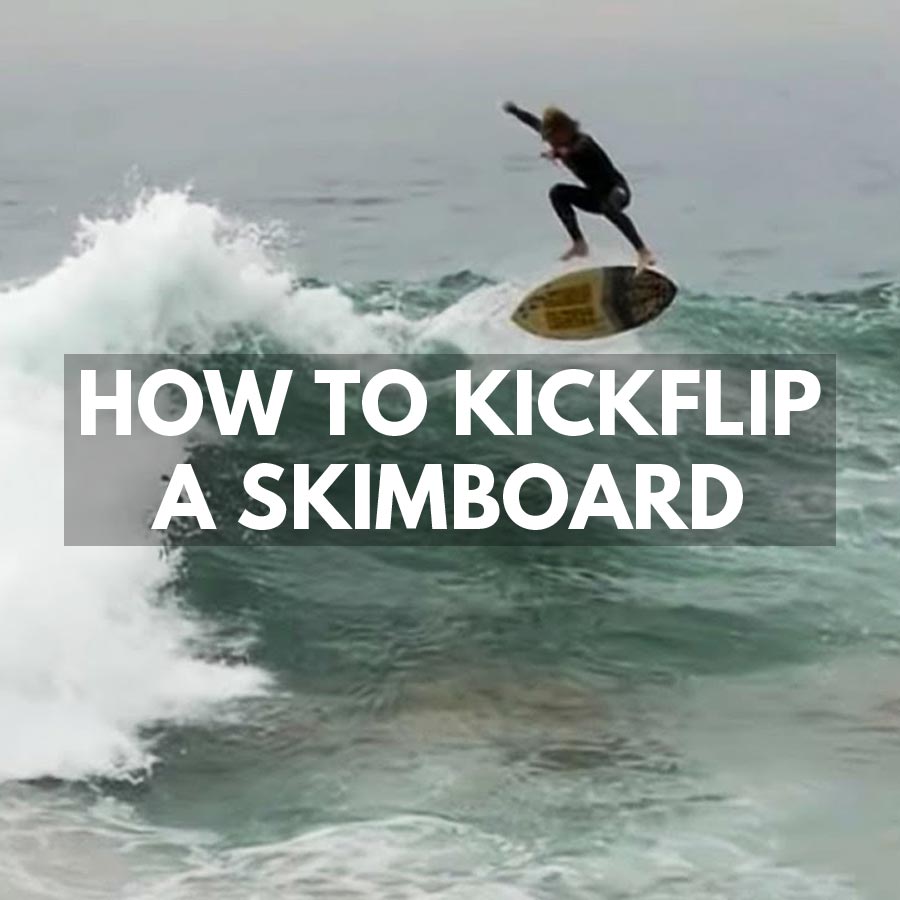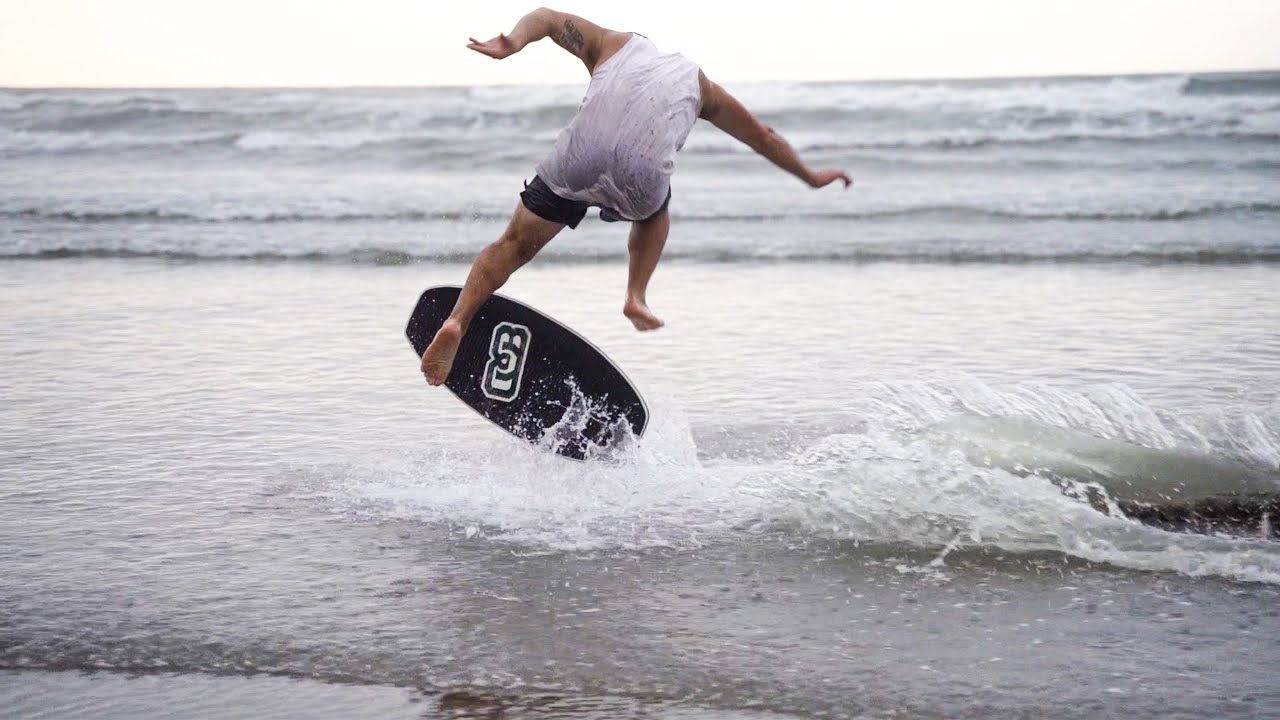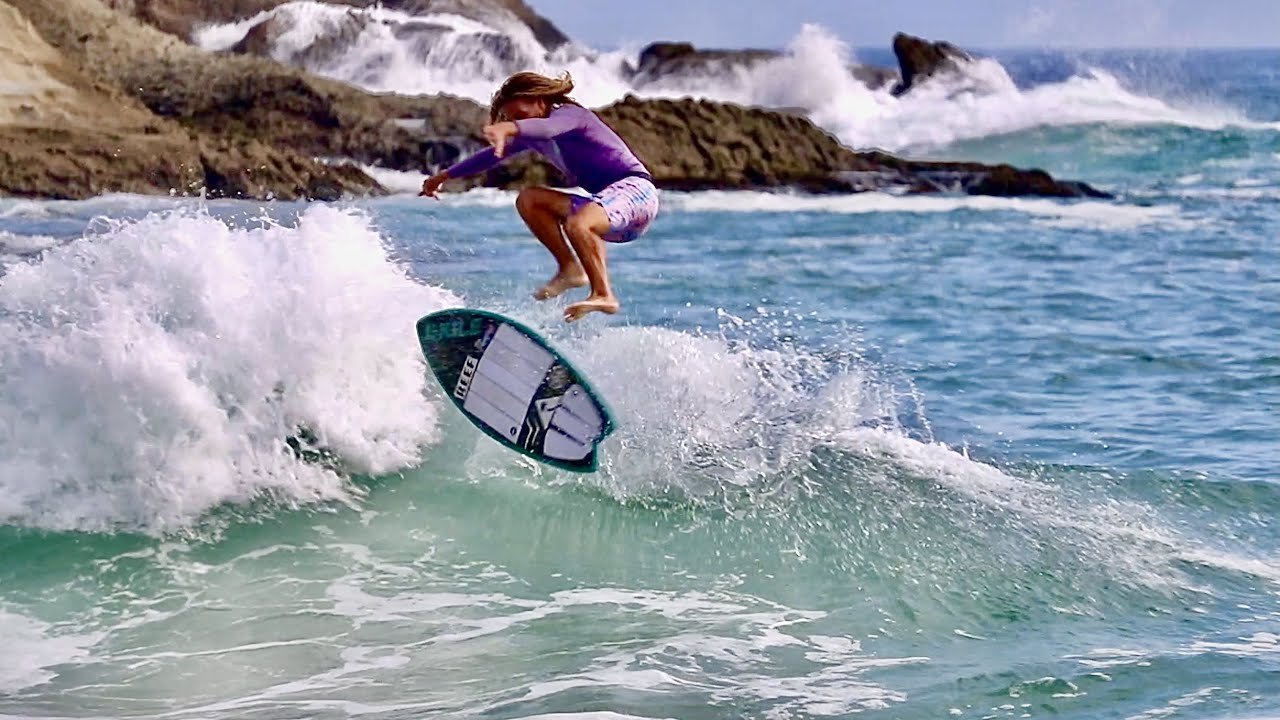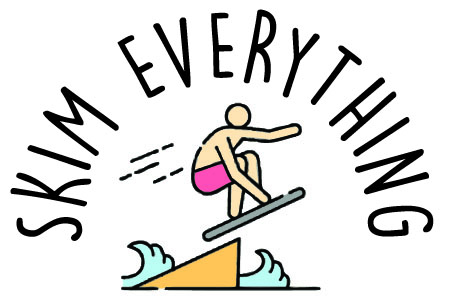
Guide to Skimboard Kickflips
In this guide to skimboard kickflips, you will learn why kickflips are arguably the hardest trick to learn on a skimboard. So read the guide fully and by the end, you will have the know-how to get the job done.
The skimboard kickflip comes from skateboarding and while it looks the same, there are some differences in technique. The skimboard kickflip needs you to kick or flick your front foot almost diagonally and forward to your backside (the direction, not your rear end). This flips the skimboard around completely from its nose-to-tail axis a full 360 degrees and looks damn impressive.
If you can kickflip a skateboard, you’re already halfway to a kickflip on a skimboard. Hint: practice on a skateboard.
What is a Skimboard Kickflip?
A kickflip on a skimboard is where the board flips 360 degrees around its longitudinal axis (the axis which runs nose to tail). Imagine a rolling pin on its side, rolling over. Same style of motion.
This trick originated in skateboarding from Curt Lindgren in approximately 1978 and was made popular by Rodney Mullen in the 1980s. Skateboarding considers the kickflip as a common trick. In skimboarding though, the kickflip is arguably one of the hardest tricks to master.
Check out this video of a skimboard kickflip.
Can You Kickflip a Skimboard?
You can kickflip a skimboard with practice and good technique. The kickflip needs air, so you need to have ollies down first. You can also do a kickflip off a ramp-like an oncoming wave or a physical obstacle.
The skimboard is a big flat surface so the wind can play a factor when practicing kickflips. As your board becomes airborne the wind can catch it and interfere with how the board flips. Keep this in mind on windy days.
The kickflip is a trick that will take time to master. So be patient with yourself and take your time.

Doing a Kickflip On a Skimboard Vs. a Skateboard
There is no doubt that doing a kickflip on a skateboard is much easier than on a skimboard.
A skimboard is wider, lighter, and is not concaved the same way a skateboard deck is. This means it is harder to start the flip.
The skimboard will suffer a bit of air resistance when flipping due to its flat and wide shape. It does not have the wheel and truck mass of a skateboard to give it rotational momentum.
The technique can be a little different too, due to these factors. The skimboard can be flipped with the underside of the foot doing a ‘stomp’ style motion. Whereas in skateboarding we must use the top side of the foot to flick the board. This is the reason that skaters’ shoes are ruined on the top of the toes!
How to Do a Skimboard Kickflip: Step-by-Step Guide
This guide assumes you are comfortable doing an Ollie or getting some air off a ramp (oncoming wave counts as a ramp!). The least air you’ll need is the width of your board plus a little bit, so it can flip nicely. This trick will take many attempts to master so be patient and persistent. You can do it!
Prepare Your Stance
Have your shoulders semi-square onto the board. You don’t want both shoulders front-on to your direction of travel, you don’t want them fully side-on either. They should be somewhere in between. Approximately 45 degrees from your direction of travel.
The feet should also be at this same angle. This stance allows you to see what you are doing and makes for an easier “kick”
Get Some Air
Whether it’s a pop and ollie or a ramp launch doesn’t matter. You need at least as much air as your board is wide. Makes sense… it needs to flip right?
Getting air off ramps and from ollies is the precursor to kickflips. Ollies can be done at a slower speed than launching off a ramp so they are a great place to start.
Tap, Flip, or Kick the Board on One Side
Now the kicker here (pun intended) is that there are two forms of kick; The flick and the kick-down.
- The flick. this is the same technique as in skateboarding. We roll the foot/lower leg under a little bit and then flick the board with the topside of our foot/toes in a motion which takes our foot forward and out. About 45 degrees out to the left (for a natural footer).
The flick method is great for ollies and steep ramps/waves because these air methods make the skimboard a bit more vertical and give you less space to work with anyway. Your normal front foot “leveling” motion in the air can be used for the flick! The next “kick down” method works well for less steep airs.
- The Kick-down. This method uses the underside of the foot and is basically a momentary little stomp. Hit the board down into the flip motion with the ball of your foot. This needs to be done as off-center as possible to make the board flip. Otherwise, it will just fall down with no flipping!
- Here is a brilliant video of the kick-down method. We can see the “stomp” very clearly. See how after the ollie the front foot needs to come off and then back down onto the board… this is much harder to do if the board pops very vertical.
There’s no perfect formula for which technique to use. It’s all trial and error. Find what works for you.
Lift the Knees
At the same time as the flick, we need to lift our back leg (think to lift the knee, not the leg). This does two things. It gives us certain leverage to do the flicking motion and it creates space for the board to flip.
The front knee needs to also be raised directly after the flipping motion. To make space and prepare for the landing.

Stomp the Landing
Now your knees are up and your board is flipping through the air. Prepare your feet and mind for the landing. Have your legs bent for this (they should be anyway) and absorb the landing to ride away with speed and flow.
In a perfect world, both feet would land on the board at the same time in the landing. This doesn’t always happen and is not so important. If your center or “core” is in front of your rear foot, the landing will be nice. Hint: make your center (like your belly button) in front of your rear foot. If it’s behind it, you’ll stack it.
In skateboarding, there is a “catch” moment where you catch the board back onto your feet before landing. This doesn’t seem to matter so much in skimboarding unless your air is massive! So don’t worry about catching the board with your feet, more so worry about getting your feet out of the way of the flipping board!
Do You Need to Wear Shoes to Kickflip a Skimboard?
You do not need shoes to do a skimboard kickflip. You can, of course, wear shoes if you wish. In the ocean, it may increase the likelihood of rolling your ankle if you wear shoes. Reef boots or rock climbing-type shoes are a great alternative to shoes for skimboarding.
However in flatland skimboarding, if not on sand, please wear shoes.
Is Kickflipping a Skimboard Easier than A Heelflip?
Kickfliping a skimboard is definitely easier than a heelflip. We tend to have more control with the toes and the front of our foot than the heel. By all means, try a heelflip, but get good at kickflips first. They come more naturally.
We hope you found this guide to skimboard kickflips useful in your training and you now have the skills you need to practice.







[…] up and the board spins around underneath you while always remaining the correct way up (not like a skimboarding kickflip). The board spins a minimum of 180 degrees so that you can continue in a forward motion however […]